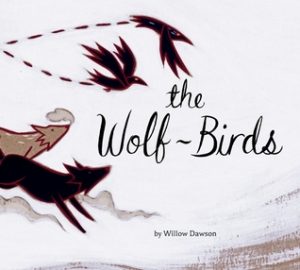This is the last post in the Avian Matters series – hurrah, for me! As for you, dear readers? Whatever will you have to look forward to now? Don’t you worry; you can always revisit the previous posts in the series, as well as take a look at the entire Dive Into Reading series I posted earlier if you missed that before.
Now if everything above the cut kind of looks and sounds a bit more like we’re talking around birding rather than introducing you to it… you’re absolutely right! That’s exactly what’s going on. It appears throughout the memoirs below that birding is not just an activity you can separate from the rest of your life like perhaps other hobbies (though arguably, you can’t really separate other hobbies from the rest of your life either, seeing as they inform your life, still), and helps to make sense of other events by putting them into perspective. I suspect it has something to do with the patience that birding inspires, as well as the sense of wonder once your eyes have been opened to what is all around you (such as the many different types of sparrow – yes, there is more than just one species of sparrow). I think Crow Planet, despite all my quibbles about it, would go wonderfully with this post, as Haupt does exhort you to become an urban naturalist and pay attention to what is around you even as you go about the concrete jungle.
Below the cut, you’ll find introductions to birding as well as a couple of field guides that tell you about birds in Ontario.
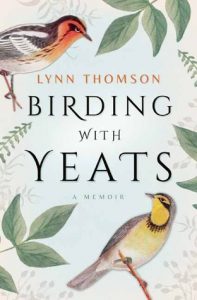 Birding with Yeats caught me way off guard, in part because I was expecting it to be about a different Yeats and possibly birding in his poetry or in his life, but also because of how intimate the entire piece of writing is. It’s almost as though Thomson is writing a diary and trying to chronicle the events before she forgets: these chapters seem to parallel somewhat Yeats’ lists.
Birding with Yeats caught me way off guard, in part because I was expecting it to be about a different Yeats and possibly birding in his poetry or in his life, but also because of how intimate the entire piece of writing is. It’s almost as though Thomson is writing a diary and trying to chronicle the events before she forgets: these chapters seem to parallel somewhat Yeats’ lists.
Lynn Thomson walks us, the reader, through her experiences with her son, Yeats, from when he was a child to when he has grown older and is looking to become more independent of her. Birding with Yeats is beautifully written reflection on both Thomson’s relationship with her son as well as their unique relationship with birds and with nature. The very activity of birding brings the two together in comfortable silence and forges a bond between them in the common love of birds and their appreciation of the awe that they inspire, while at the same time giving each of them strength throughout the trials that they encounter. While at times I’m tempted to think Thomson’s chronicling of her close relationship with her son might be a rather selective telling of the story, it is certainly very beautiful and touching.
The pace is unhurried and gentle, where even the most catastrophic of events doesn’t really make you nervous in the least because it’s as though Thomson is writing not entirely from her own perspective, which is probably why I feel that something is missing from the memoir, but it’s definitely a beautiful work that repeatedly brings us back into nature. I’m a bit disappointed that there weren’t more descriptions of the actual birding excursions themselves, and that the focus was more on the relationship between mother and son, but that’s exactly what Birding with Yeats purports to show, so it’s a bit unfair of me to say so. I did find that as it went on, the writing felt more and more like a list of things that had happened rather than an introspective reflection on events past, though. On the other hand, extra points for being local!
(It’s a bit of an adventure reading through this at times because there are short references to both Yeats and Keats, and I couldn’t switch between the two different ways of pronouncing “-eats” quickly enough before the next Yeats came up – and this one being Thomson’s son, not the celebrated poet, though Thomson notes he’s a poet in his own right.)
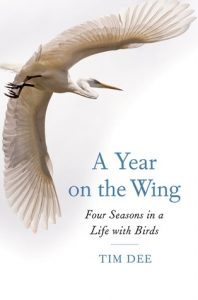 A Year on the Wing by Tim Dee covers much more than just the one year, as Dee’s retelling of his impressions of and experiences with birds month-by-month are informed by his experiences with them throughout his entire life, both personal experiences such as his many years of working with guillemots, as well as literary experiences. Beautifully written in a lyrical prose, the year passes by in a flurry of wings rather than a straightforward path from A to B. Think of a murmuration of starlings, in the way the shape of the flock changes from second to second* – that’s the sort of prose you’ll find here with Dee.
A Year on the Wing by Tim Dee covers much more than just the one year, as Dee’s retelling of his impressions of and experiences with birds month-by-month are informed by his experiences with them throughout his entire life, both personal experiences such as his many years of working with guillemots, as well as literary experiences. Beautifully written in a lyrical prose, the year passes by in a flurry of wings rather than a straightforward path from A to B. Think of a murmuration of starlings, in the way the shape of the flock changes from second to second* – that’s the sort of prose you’ll find here with Dee.
Another pure celebration of birds in all their idiosyncratic wonder, A Year on the Wing should surely convert you into a bird lover! (To be honest, I did find it a touch too flowery – though not poorly written by any means – so I can’t recommend it for everyone, but if you do enjoy reading lyrical prose, this should make your next-reads list.)
*If you want to know more about that, take a look at this Quanta magazine article.
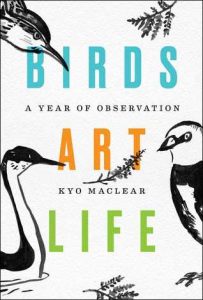 Birds Art Life by Kyo Maclear won’t teach you how to birdwatch, but it’s certainly an interesting recounting of how Maclear herself learned to fall in love with birds. That’s not really it, though – it’s more Maclear’s recollection of getting back on her feet after the death of her father, and the ways in which birdwatching featured into that with the help of a young fellow who allowed her to accompany him for a year as he went around his own birdwatching adventures. The two never really leave for the spectacular or exotic, preferring instead to seek beauty in what is plentiful, or perhaps an unexpected visitor, closer to home. I think this touches also a bit on the concept of hygge, which I’ve posted about before, but there’s something of becoming able to recognize the beauty in the small and ordinary that surround us, to recognize that they are extraordinary in their own right. (I think Sarah McLachlan gets it on the dot with Ordinary Miracle, which you can find on either of these 2 CDs we have in our collection: With Glowing Hearts & Rarities, B-Sides and Other Stuff vol. 2).
Birds Art Life by Kyo Maclear won’t teach you how to birdwatch, but it’s certainly an interesting recounting of how Maclear herself learned to fall in love with birds. That’s not really it, though – it’s more Maclear’s recollection of getting back on her feet after the death of her father, and the ways in which birdwatching featured into that with the help of a young fellow who allowed her to accompany him for a year as he went around his own birdwatching adventures. The two never really leave for the spectacular or exotic, preferring instead to seek beauty in what is plentiful, or perhaps an unexpected visitor, closer to home. I think this touches also a bit on the concept of hygge, which I’ve posted about before, but there’s something of becoming able to recognize the beauty in the small and ordinary that surround us, to recognize that they are extraordinary in their own right. (I think Sarah McLachlan gets it on the dot with Ordinary Miracle, which you can find on either of these 2 CDs we have in our collection: With Glowing Hearts & Rarities, B-Sides and Other Stuff vol. 2).
And if you’re a bit more into birdkeeping rather than birdwatching, here’s a great review on The King of the Birds, a picture book about Flannery O’Connor and her peacocks! We don’t own the book, but as always, ILLO is an option that is available to you.
Now we’re ready to move onto introductions to birding below, as well as a couple of field guides so you’ll be able to positively identify whatever flies your way (well… maybe not whatever flies your way, but at least some of them)! So if you’ve been wondering what that bird of prey making the rounds over your head is, or perhaps wondering what kind of seagull it is that we even have here, because we just call them seagulls, really, then look no further – I (probably) have the book for you!
Continue reading →
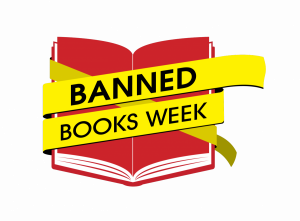 I was all set and ready with another post, but thank goodness basically everything I’m subscribed to threw the reminder into my face at every turn that this week is Banned Books Week!
I was all set and ready with another post, but thank goodness basically everything I’m subscribed to threw the reminder into my face at every turn that this week is Banned Books Week!


